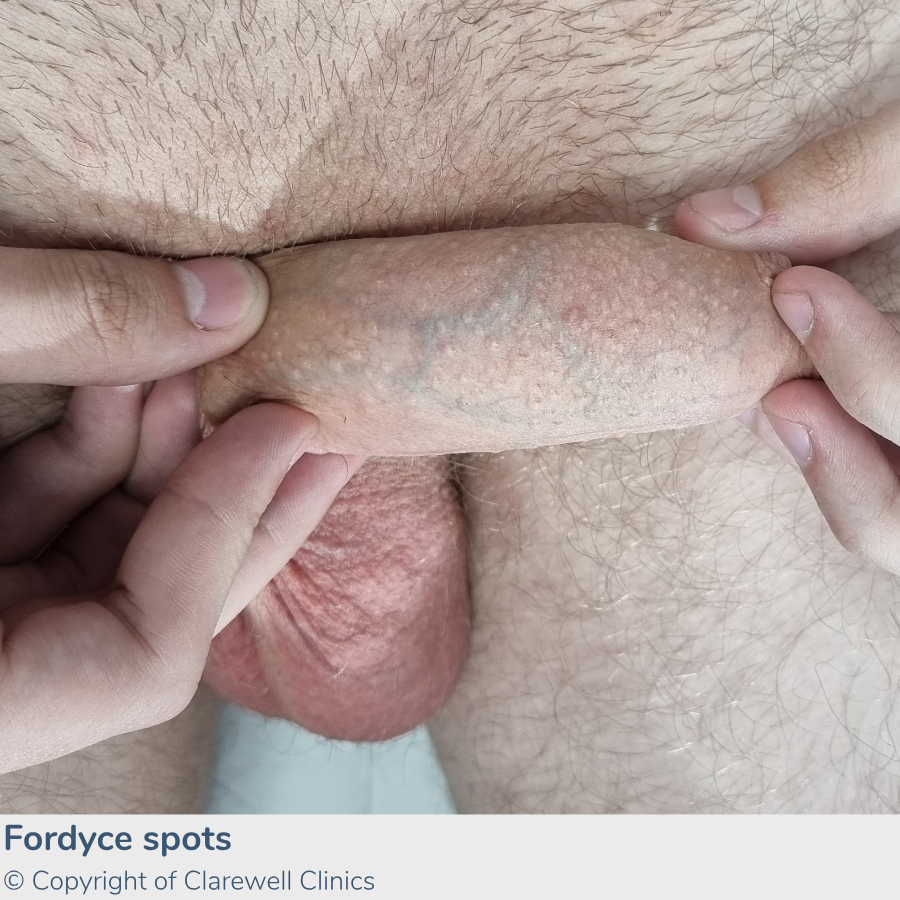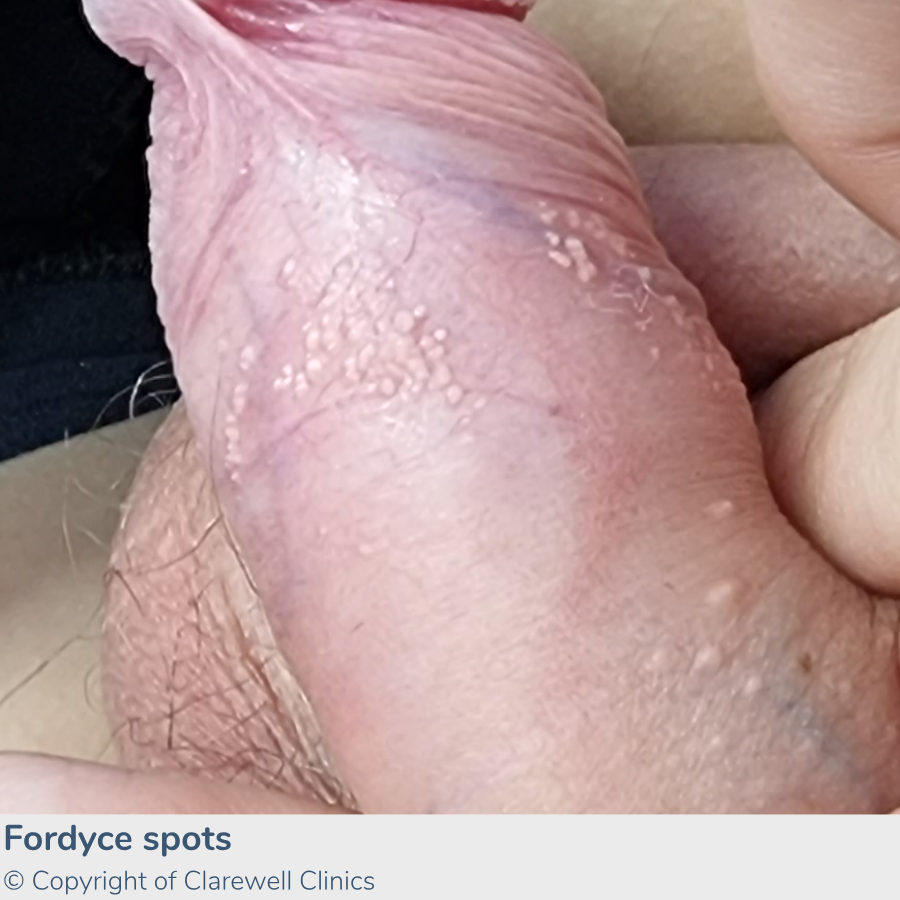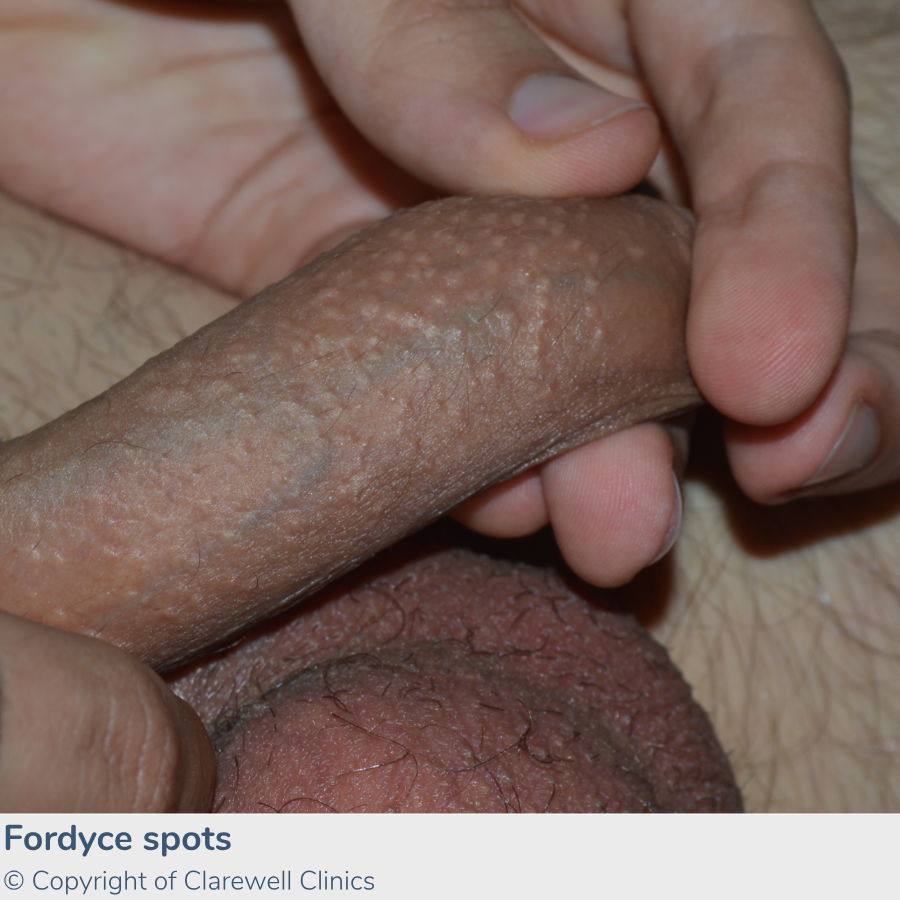
Fordyce Spots
Fordyce spots are normal, harmless and not a result of any infection. In fact, most people have them somewhere on the body, and they pose no risk to your health.
However, Fordyce spots can often mimic other conditions such as genital warts (caused by infection with human papilloma virus, HPV), genital herpes (caused by infection with herpes virus), so it’s important to see a healthcare professional if you are worried about other conditions.




Symptoms of Fordyce Spots
Fordyce spots or Fordyce granules are sebaceous (oil) glands that appear as small bumps on the skin. Named after an American dermatologist, John Addison Fordyce, they most often appear close to mucosal (moist) surfaces, such as on the lips, inside of the cheek or the genitals. Where these sebaceous glands appear at the frenulum of the penis, they are sometimes referred to as Tyson glands, after the English physician, Edward Tyson.
Spots can range in size, from less than 1 mm, up to 5 mm, may be flat or slightly raised, and can appear white, yellow, red or flesh coloured. They may occur as just one spot, however commonly exist in crops of 50–100. As they are sebaceous glands, if squeezed, they may produce a white or yellow thick material. However, squeezing the spots is not recommended as this can introduce infection or cause scarring.
Causes of Fordyce Spots
Fordyce spots are oil glands, which are triggered to enlarge at the onset of puberty. They are very common; approximately 80% of adults have them somewhere on the body, and those who have them tend to be born with them. They are not caused by infection or injury, and there is no way to avoid Fordyce spots.

Prognosis of Fordyce Spots
Fordyce spots persist for life and do not tend to change much over time. They may become more or less noticeable as you age; however, they do not tend to increase or decrease in number over time. Fordyce spots do not increase your risk of infection or malignancy and are not associated with systemic disease.
Get Tested with Confidence
Consultation
Testing
Treatment
Frequently Asked Questions
When do symptoms of Fordyce spots typically occur?
Individuals are typically born with fordyce spots, but they often become more noticeable after puberty due to hormonal changes in the body.
Fordyce spots are often only visible when the skin is stretched – and on the penis they are particularly noticeable during an erection.
Are Fordyce spots an STI?
No. Fordyce spots are not a disease, infection, or a sexually transmitted infection. Fordyce spots are simply a normal dermatological occurrence, and can be present in people of all ages.
However if you are at risk of contracting a sexually transmitted infection (STI), it is important to be regularly tested to rule out infections that may look similar to fordyce spots.
Do Fordyce spots cause any complications?
Fordyce spots are a naturally occurring phenomenon and do not cause any physical complications.
Individuals with Fordyce spots may be tempted to squeeze the spots, which may cause infection or scarring. However, when left alone fordyce spots do not cause any issues.
Very rarely, Fordyce spots can cause discomfort during sexual intercourse.
Can I get Fordyce spots even if I wear a condom?
Fordyce spots are not a sexually transmitted infection, so the use of condoms will not make any difference. Those with Fordyce spots already have them as part of their normal anatomy, and as they are not infectious, there is no possibility of transmission to sexual partners.
Condoms are, however, an effective way to prevent sexually transmitted infections.
Who is most likely to have Fordyce spots?
Fordyce spots can appear on anyone; however, they are twice as likely to be found in men than women, and may be more common in people with oily skin.
The presence of fordyce spots also appears to increase with age.
How can I prevent getting Fordyce spots?
You cannot prevent having Fordyce spots, as they are present at birth as a natural occurrence.
Some people choose to remove them for cosmetic reasons, but removal is not medically advised or necessary.
Can I pass Fordyce spots onto my partner?
No.
Fordyce spots are not infectious; therefore, you cannot spread them to your partner.
How are Fordyce spots diagnosed?
Fordyce spots are typically diagnosed through a visual examination.
In some cases, examination under magnification may be necessary to confidently confirm Fordyce spots and rule out other conditions.
If there is any doubt in the diagnosis, your clinician may recommend a biopsy of the lesion. This involves a small sample of the spot being removed with the aid of local anaesthetic and examined under a microscope to study the cellular structure. However, a visual examination is usually enough to make a definitive diagnosis.
Do I need an examination?
Fordyce spots are best diagnosed following a visual examination by an experienced clinician. If the spots are on the genitalia, it is important to rule out other conditions such as genital herpes or genital warts, which may require treatment. An examination is only performed with your explicit consent, and your clinician will treat you with the utmost respect and dignity.
In some cases, fordyce spots can be assessed through a photograph of the lesions, combined with a thorough discussion about the clinical history.
What other conditions look similar to Fordyce spots?
There are a few conditions that may look similar to fordyce spots, such as:
- Genital warts
- Genital herpes
- Molluscum contagiosum
- Skin inflammation such as folliculitis
- Other benign skin conditions such as milia (hard bumps on the skin, indicating a build-up of keratin)
If you are unsure whether you have Fordyce spots, particularly if they are newly visible, it is important to consult your clinician for an accurate diagnosis.
Do my Fordyce spots need to be removed?
There is no medical benefit to removing your fordyce spots. Those who choose to have their fordyce spots removed do so for the aesthetic benefit, especially in relation to their confidence.
You do not need to have your Fordyce spots removed unless you wish to do so. This is a decision that should be made after consulting with a clinician.
Author:
Page reviewed by Dr. Manoj Malu (Clinical Director)
Last reviewed date: 6 June 2021
Next review due: 6 June 2024
Whilst this content is written and reviewed by sexual health specialists, it is for general guidance only. It is not intended to replace the advice of your clinician.
References & Further Reading
- Healthline (2020): Understanding Fordyce Spots
- StatPearls (2020): Sebaceous Hyperplasia
- DermNet NZ (2014): Fordyce Spots
- Medical News: Fordyce spots: Treatments, risk factors, and symptoms
- Annals of Dermatology: Clinicopathologic Manifestations of Patients with Fordyce’s Spots
- Clinical Case Report and Reviews: Fordyce Spots
- PubMed: Fordyce’s spots: disease, heterotopia or adenoma? Histological and ultrastructural study
- American College of Dermatology: Fordyce Spots
- BMJ: Fordyce Spots
- Primary Care Dermatology Society: Fordyce Spots


